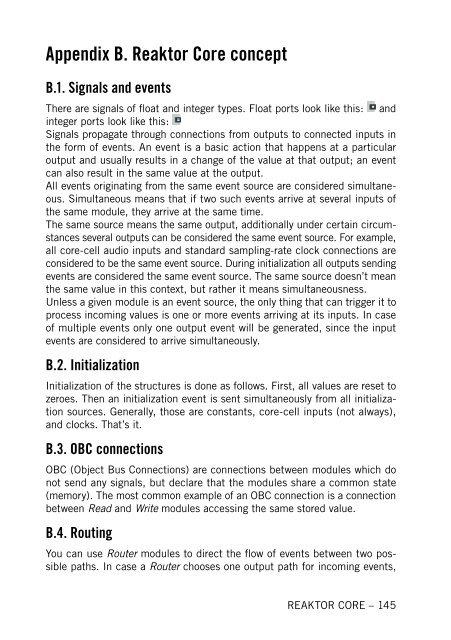1. First steps in Reaktor Core - Native Instruments
1. First steps in Reaktor Core - Native Instruments
1. First steps in Reaktor Core - Native Instruments
Create successful ePaper yourself
Turn your PDF publications into a flip-book with our unique Google optimized e-Paper software.
Appendix B. <strong>Reaktor</strong> <strong>Core</strong> concept<br />
B.<strong>1.</strong> Signals and events<br />
There are signals of float and <strong>in</strong>teger types. Float ports look like this: and<br />
<strong>in</strong>teger ports look like this:<br />
Signals propagate through connections from outputs to connected <strong>in</strong>puts <strong>in</strong><br />
the form of events. An event is a basic action that happens at a particular<br />
output and usually results <strong>in</strong> a change of the value at that output; an event<br />
can also result <strong>in</strong> the same value at the output.<br />
All events orig<strong>in</strong>at<strong>in</strong>g from the same event source are considered simultaneous.<br />
Simultaneous means that if two such events arrive at several <strong>in</strong>puts of<br />
the same module, they arrive at the same time.<br />
The same source means the same output, additionally under certa<strong>in</strong> circumstances<br />
several outputs can be considered the same event source. For example,<br />
all core-cell audio <strong>in</strong>puts and standard sampl<strong>in</strong>g-rate clock connections are<br />
considered to be the same event source. Dur<strong>in</strong>g <strong>in</strong>itialization all outputs send<strong>in</strong>g<br />
events are considered the same event source. The same source doesn’t mean<br />
the same value <strong>in</strong> this context, but rather it means simultaneousness.<br />
Unless a given module is an event source, the only th<strong>in</strong>g that can trigger it to<br />
process <strong>in</strong>com<strong>in</strong>g values is one or more events arriv<strong>in</strong>g at its <strong>in</strong>puts. In case<br />
of multiple events only one output event will be generated, s<strong>in</strong>ce the <strong>in</strong>put<br />
events are considered to arrive simultaneously.<br />
B.2. Initialization<br />
Initialization of the structures is done as follows. <strong>First</strong>, all values are reset to<br />
zeroes. Then an <strong>in</strong>itialization event is sent simultaneously from all <strong>in</strong>itialization<br />
sources. Generally, those are constants, core-cell <strong>in</strong>puts (not always),<br />
and clocks. That’s it.<br />
B.3. OBC connections<br />
OBC (Object Bus Connections) are connections between modules which do<br />
not send any signals, but declare that the modules share a common state<br />
(memory). The most common example of an OBC connection is a connection<br />
between Read and Write modules access<strong>in</strong>g the same stored value.<br />
B.4. Rout<strong>in</strong>g<br />
You can use Router modules to direct the flow of events between two possible<br />
paths. In case a Router chooses one output path for <strong>in</strong>com<strong>in</strong>g events,<br />
REAKTOR CORE – 145










